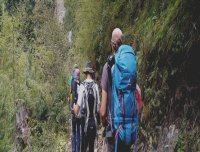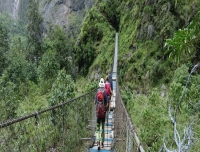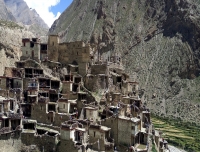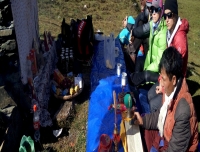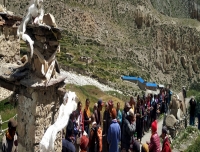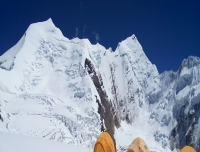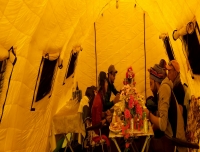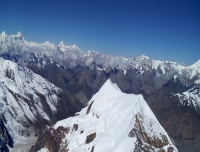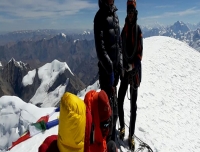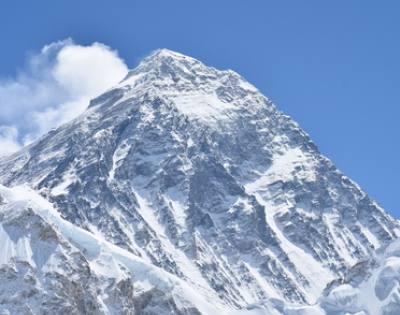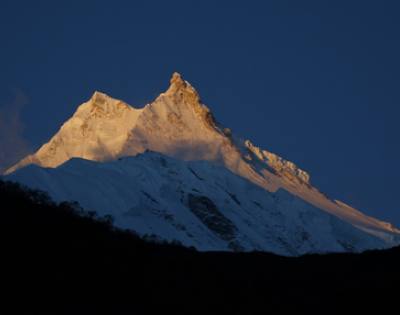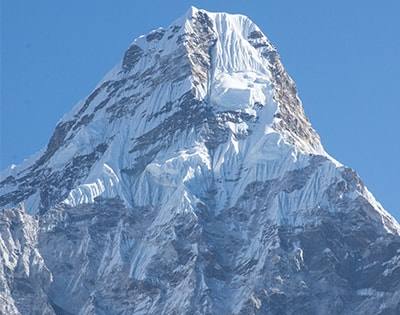- Read Reviews onTripadvisor
- Phone & WhatsApp Support+977 9851112535 (Chandra Shor)
Mt. Himlung Expedition [7,126 meters/ 23,379 ft] | 30 Days
Fact Information
- Duration
- 30 Days
- Destination
- Nepal
- Difficulty
- Difficult
- Accommodation
- Hotel, Lodge &Tent
- Activity
- Expedition
- Transportation
- Tourist Bus, Car & Jeep
- Meals
- BLD (Breakfast, Lunch and Dinner)
- Max Person
- 15
- Min Person
- 1
- Maximum altitude
- 7126m, (23,379ft)
- Best season
- Autumn
About Trip
For an adventure-filled holiday, perfect for those seeking scenic and picturesque trekking, including peak climbing, join us on Mt. Himlung expedition, one of our most popular trips.
Mount Himlung, a highly demanding peak for climbers, stands at an elevation of 7,126 meters (23,379 feet) above sea level. Located in the Himalayan range northwest of Mount Manaslu on the border of Tibet and Nepal, it can be found at approximately 28.8224° N latitude and 84.7254° E longitude in the Manang district of Nepal.
The first ascent of Mount Himlung occurred on October 25, 1992, by a Japanese team led by Yoshinobu Ohta, with climbers Masakazu Ueki, Kazuhiro Takahashi, and Nyima Tsering Sherpa. Initially called Nemjung, the mountain was extremely challenging to climb due to its route. However, the KOBLER & PARTNER expedition operator team opened a new climbing route early in the year that is less risky and challenging than the previous route.
Due to the safe climbing conditions and reasonable time and cost, Mount Himlung has become increasingly popular among novice and professional climbers. In my opinion, Mount Himlung is one of the safest mountains in the world, with no reports of accidents, lost climbers, or property since the new route was opened.
With proper preparation, including 30 to 35 days of vacation time, the necessary equipment, good acclimatization, and physical fitness, Mount Himlung is not a difficult peak to climb. Mount Himlung offers unexpected wonderful experiences for climbers. To reach the summit at 7,126 meters (23,379 feet), climbers must travel by car or jeep from Kathmandu via the famous Annapurna circuit route, and then trek through the ancient lands of the Khamba Tibetan people. Along the way, tourists will witness breathtaking views and visit Buddhist villages such as Nar and Phoo, as well as yak and sheep huts. During the summit push, climbers will need to traverse huge moraines, climb over rocky terrain and permanent snow fields, navigate crevasses, and finally ascend a 75-80 degree vertical slope with the support of fixed line ropes and a guide rope. Upon reaching the summit, climbers will be rewarded with breath-taking panoramic view. From top, we can see Mount Manaslu in front of us, as well as Mount Annapurna, Mount Dhaulagiri and numerous other mountains around us.
If you're interested in climbing Mount Himlung, consider joining our international expedition group. We have set up a luxurious base camp during the peak climbing seasons and are available 24/7 to provide you with the best service. Don't hesitate to email us.
Trip Highlights
Join us Himlung Expedition campaign 2023:
We organize commercial Mount Himlung expeditions for mountaineering enthusiasts of all levels, offering a 7,000-meter high altitude peak climbing experience at a reasonable price. Our priority is to provide an opportunity for everyone to experience the thrill of climbing a 7,000-meter mountain, regardless of their previous climbing experience. Whether you are an experienced climber or a beginner, you are welcome to join our expedition.
We do not require any previous climbing experience, mountaineering training, or age restrictions to make a successful climb of Mount Himlung. However, we do require participants to have a moderate level of physical fitness and good acclimatization to ensure their safety, enjoyment, and a successful climb. To ensure a comfortable, enjoyable, and successful expedition, we provide high-quality climbing gear, training, meals, and support staff. Our team, who have recently successfully summited Himlung, are experienced and skilled in guiding climbers to reach their goals.
We have established a permanent and deluxe base camp for climbers' comfortable stay and the extended Himlung expedition from early September through the end of November. You can join us at any time during this climbing period. We offer different categories of climbing services, and you can choose the services that suit your needs, such as permits and base camp service, permits, base camp, and guide services, or full package service.
At base camp, we provide each member with an individual Nepali-made box tent and a compact, waterproof sleeping mat. We also have a kitchen tent, heated dining tent with solar lights, armchairs, communication, storage, showers, and toilets, all maintained in pristine hygiene. Our Nepalese climbing guides each have their own individual tent, dining hall, and storage tent, while other members of the base camp staff share two-person tents. Our highly skilled expedition chef prepares delectable and sanitary meals throughout the climb, and our expedition team manager oversees all essential logistics and climbing essentials for a successful ascent.
At Himalayan Diamond Adventure, we prioritize top-quality food service and offer fresh vegetables, fruits, meats, and baked goods, as well as a broad selection of hot and cold beverages, including beer, coke, sprite, wine, and hard drinks.
Outlined Itinerary
Day 01: Arrival in Kathmandu airport 1,350m (4,429 ft), transfers to hotel included breakfast.
Day 02: Expedition preparation days, such as meeting, permits and equipment check.
Day 03: Drive from Kathmandu to Besishar-Koto 2,600m (8,530 ft), about 250km, 9 -10hrs.
Day 04: Trek from Koto to Meta 3,560m (11,679 ft), 8hrs.
Day 05: Trek from Meta to Kyang 3,820m (12,533 ft) 4hrs.
Day 05: Trek from Kyang to Phu-gau 4,080m (13,386 ft), 4hrs.
Day 06: Rest Day in Phu-gau, hike to uphill for acclimatization and panoramic mount view.
Day 07: Trek to Himlung base camp 4,750m (15,584 ft), 4 hours gently up way.
Day 08- 24: Climbing time 18 days, set up camp I, II, III and summit back BC.
Day 25: After successful climbing switch back to Meta [3,560m/11,679ft], 7/ 8hrs.
Day 26: Trek back to Koto 2,600 meters (8,530 ft), 6hrs.
Day 27: Drive back to Kathmandu 1,350m (4,429 ft), 10 to 11hrs.
Day 28: Attend in Nepal tourism board for final clearance (Only Expedition team leader).
Day 29: Contingency days, farewell dinner.
Day 30: Departure for home.
Detailed Itinerary
Day 01: Arrival in Kathmandu Tribhuvan International airport and transfer to hotel.
Representatives from Himalayan Diamond Adventures will greet you upon your arrival at Tribhuvan International Airport in Kathmandu. You will be welcomed with a fresh flower garland, a traditional Nepali greeting, and then escorted to the hotel for bed and breakfast service. The drive from the airport to the hotel takes approximately 15 to 20 minutes, if there is no traffic jam on our way. After checking into the hotel, we will have a short refreshment meeting at the hotel. In the evening, the company will host a welcome dinner at a traditional Nepali restaurant, complete with a cultural dance performance, to celebrate the start of your trip. During the dinner, your guide will provide a brief overview of the schedule for the following day.
Day 02: Special climbing preparation day, such as permits, gears, and equipment.
Today early morning we stay meeting, our group leader will brief us about the expedition. After our meeting, our group leader and the company representative will visit the Nepal tourism board for expedition briefing and legalization to get expedition permits. Meanwhile, our guide and rest of climbers have to reconfirm your necessary climbing gear and equipment for trekking and expedition. If we found you don't have proper equipment and gears, he will help you to collect or take in hire in the trekking shops of Thamel. And in the evening our team leader will brief us about the day program of tomorrow.
Day 03: A scenic bus journey to Chame 2,670m, (8,760 ft), about 250 kilometers, 10 to 11hrs.
Today, we'll take a scenic bus ride from Kathmandu through the prithvi highway and the famous Annapurna Circuit Thorong La pass route to Chame, the headquarters of the Manang district. It's about 270-kilometre journey and it takes 10 to 11 hours by private jeep. During the journey, we'll enjoy stunning mountain terrain views, including the Ganesh Himal range, Buddha Himal, Rani peak, a group of Himalachuli, Ngadichuli, and Manasalu. We'll also see many white rivers and tributaries, green hills, and the farmers' cultivated terraced lands and villages.
Day 04: Trek to Meta 3,560m, (11,679 ft0, 8hrs, trek into ditch wooded lands. Overnight at the lodge:
This morning, we'll start the trek very early, as is usual for long days. We'll head north towards Nar-Phu and the border of Tibet. Just past the Koto check post, we'll cross the crystal-clear Marsyangdi River via a suspension bridge that leads to the Nar Phu valley. We'll trek through a very narrow valley amidst beautiful woods, following the course of the Nar Phu Khola (River). Continuing to climb through the forest, we'll emerge from the narrow canyon, and the trail will pass right under a giant rocky hill. From this point, the woods will thin out, and the vistas will widen. Soon afterward, we'll trek past several small cave shelters and a Dharmasala, or pilgrims' rest house. We might camp at Dharamsala, but more likely, we'll continue on and make the steep climb up to a small plateau along a small, scenic trail to the high grazing pastures of Meta. Meta is located beneath Mount Kagaru at an elevation of 3,560 meters (11,679 ft). This place offers majestic views of Annapurna II and Lamjung. Meta is a small, picturesque tourist destination beyond the Himalayas.
Day 05: Trek to Kyang 3,820m (12,533 ft), 5hrs of walk through amphitheater valley. Overnight at Lodge:
Our hike today is one of the loveliest walks in the Himalayas. The trail is much easier than yesterday, and the landscape completely changes. We'll see white rocks, low shrubs and juniper, scattered evergreens, delicate brick-red and orange leafed bushes, crumbling shelves of flat slate, white sandy trails, and gnarled trees. The mountains around us are utterly spectacular, and the Phu River shadows the trail far below. About an hour past Meta is Junam, the second semi-permanent settlement, where 'Khampas' from Tibet sometimes sheltered. Above the trail to the right looms a massive glacier, which falls jaggedly down to the high pastures above us. It's all truly amazing scenery. Across the river, the next semi-permanent settlement is Khampa, which is like a big grassland field, with a few tea houses. It's a good spot for trekkers to have a lunch break. From Khampa, the trail passes another old permanent settlement of Khampa, Kyang, and tonight we'll sleep at Kyang, the extensive winter settlement of Phu, on a plateau high above the river. Kyang is a flat plateau with an extensive mani wall and is one of the most scenic lodges with soaring cliff walls surrounding us.
Day 06: Trek to Phoo village 4,080m (13,386 ft), 4hrs of walk, into the deep gorge. Stay in the lodge:
Today, we will be heading towards the Phoo valley, a unique village that can be viewed through a scenic rocky path in a canyon gorge. The Phoo people resemble Tibetan people in their language, attire, and lifestyles. The area is still rich in natural and cultural diversity. In the past, we visited the famous Tashi Lhakhang Gompa on a neighboring hillside to pay our respects to Lama Karma Sonam Rimpoche, a tulku who arrived in Nepal with His Holiness the Dalai Lama in '59. He is renowned as an Amchi, or Tibetan doctor, as well as a Thanka painter and father of several children (as some tulkus and certain lamas are permitted to marry). This place is believed to be the origin of Buddhism in Nepal.
Day 07: Visit of Phoo monastery 4,300m (14,107 ft), or hike above Phoo gau. 5,000m (16,404 ft).
We will be spending an extra day in the same place to meet the local Phoo residents and do some exploring in the wide valley above us. While Tibet is too far for a visit, we can still walk up the valley to the summer grazing settlement or 'Kharka' at Ngoru, which is a three-hour walk past the gompa. For those with lots of energy, a hike towards the east through a glacial valley leads to Himlung Himal base camp, where expeditions often climb this peak as well as nearby Nyajug Kang. The mountain views are tremendous.
Alternatively, walking west up past Phu towards the Chortens on the hillside provides incredible vistas and views of Phu and its surrounding fields, forts, valleys, and peaks. Phu itself is an incredibly beautiful village, and for photographers, the light is spectacular, with deep blue skies and the chance to spot blue-sheep (mountain sheep) on the surrounding hillsides.
Day 08: Trek to Himlung base camp 4,750m (15,584 ft), 4hrs of gently up way.
Today, we will head towards Himlung base camp, located at an altitude of 4,750 meters (15,584 ft). We will depart from Phoo Gaun and follow a narrow, rugged path through summer grazing lands where yaks and horses’ roam. After about 4 hours of hiking on an off-beaten trail with breathtaking landscapes, we will reach base camp and meet the rest of our staff. We can settle into our individual tents and rest. Later, the group leader will convene a meeting with our base camp staff to discuss camp management, and our guide will provide a briefing on logistics and safety protocols.
Day 09 – 24: Entire climbing periods for Mount Himlung 7,126m (23,379 ft), CI, CII &CIII summit and back to Base Camp:
Day 25: After a successful Himlung expedition, we will make our way back down from Base Camp to Meta.
After a successful Himlung expedition, we will make our way back down from Base Camp to Meta,which is located at an altitude of 3,560 meters (11,679ft). The descent will take us about 6 to 7 hours via the same path we took up. We will spend the night at a lodge in Meta. We are all looking forward to sharing our excitement with our loved ones and celebrating our successful summit of Mount Himlung
Day 26: Trek to Koto 2,600m, (8,530 ft), 6 hours.
Today, after a long time of staying in the mountains, we are taking our final hike down to Koto via the same route we took on our previous trek. Tonight, we will celebrate our successful trip by arranging some drinks and a variety of local snacks.
Day 27: Drive back to Kathmandu via Besisahar 10hrs in a private Jeep:
Finally, we will drive back to Kathmandu city with wonderful memories of our trip. It will take us approximately 10 to 11 hours by private jeep.
Day 28: We will have a day briefing at the Tourism Industry Division for the team leader, and a leisure day.
Today is a relaxing or shopping day, and you are free to make side trips around the valley. In the evening, the company will organize a very special farewell dinner at a tourist-standard restaurant with Nepali cultural dance.
Day 30: Departure for home:
We will drop you off at the Tribhuvan International Airport in the terminal room during your flight check-in time and see you off.
Note:- that the outlined itinerary is designed for those who prefer a full package service. However, we understand that preferences and time constraints may vary, so we offer the flexibility to customize the itinerary according to your needs. The selection of itineraries and staff will be based on your specific requirements and budget. Additionally, we have options available for partial visits to accommodate your preferences and financial situation.
Cost Details
What's included
Services and Equipment Included in $9,000.00:
Transportation Services:
- Airport pickup and drop-off by a private vehicle as per the trip itinerary.
- Private Car or Bus transportation from Kathmandu to Koto and back Kathmandu
- Luggage transport as per the itinerary is included
Accommodations:
- 4 nights' stay at Hotel Moonlight in Kathmandu, inclusive bed and breakfast service
- T-house (lodge) accommodations during the trek, that are clean and comfortable
- Base Camp/ Camp1/ Camp2 in the tent ⛺
Food and Beverages:
- Three meals a day (breakfast, lunch, and dinner, along with dessert) and hot drinks (tea and coffee) are included during the trek.
- The menu is as per the client's choice
- At Base Camp, we have our own kitchen services.
Permits and Fees:
- Peak royalty, Annapurna Conservation Area Project fees, and TIMS Fee
- All necessary trekking and climbing permits
- Route opening charge/ rope fixing charge
- Garbage management fees (human waste shipment transfer and garbage deposit)
- Necessary documentation and governmental official paperwork and taxes/VATs
- Government liaison officer with insurance, daily allowance, equipment, and transportation
Guides and Support Staff:
- English-speaking, well-trained, skilled, and experienced high-altitude porters and 1 guide each member above camp -3 with daily salary, lodging, food, transportation, and accommodation
- Base camp manager with equipment, daily salary, lodging, food, transportation, and accommodation
- Base camp chef with equipment, daily salary, lodging, food, transportation, and accommodation
- Base camp staff and kitchen staff with equipment, daily salary, lodging, food, transportation, and accommodation
Equipment and Supplies:
- Oxygen (4litres summit or 4litres Russian cylinder bottles only for the emergency use.
- Mask and regulator (1 set per member, plus spares for the team) only for the emergency use
- Necessary porters to transport member belongings to base camp and from base camp to Koto
Our Base Camp service:
- Each Member will be provided with individual Nepal made box Tent Mattress and Pillow at Everest Base Camp
- Common service for Nepali and foreign tents, mattresses, comfortable dining hall, kitchen tent, store tent and toilet tents with Sola lights facility.
- Freshly cooked meals (Breakfast, Lunch & Dinner): Continental, Nepali, Indian and Chinese with hot drinks, Tea and Coffee
- communication tent, Satellite phone and Radio set
Our Higher Camp services:
- High Altitude, Medical & Helicopter rescue insurance for Climbing Sherpa, Cook, and involved Nepalese staffs
- Higher camp services including necessary equipment, gears, and high-altitude food
- Cooking gas, EP gas, cooking pots, high-altitude tents, and climbing gear (static ropes, guide ropes, snow bars, ice crews, carabineers, etc.)
- Communication: Satellite phone and Radio set
Our Crucial services:
- Strong and helpful porters with proper equipment or yaks, or helicopter transportation alternative transportation only the expedition stuffs.
- Medical supplies (first aid kit available)
- Nepalese staff insurance policy covering rescue evacuation, medical treatment, hospitalization, and accidental
- One emergency helicopter rescue insurance for Nepali staff
- Government taxes and official expenses
- Welcome and farewell dinner at a tourist standard restaurant
- Emergency contact and emergency plan
Services and Equipment Not Included in $9,000.00:
- Meals while staying in Kathmandu Hotel for lunch and dinner
- Extra night accommodation in Kathmandu due to early arrival, late departure, or early return from the mountain for any reason
- Personal trekking and climbing equipment and gear
- International airfare
- Nepal entry visa fee
- Entry fees for temples or monasteries, donations, or charity
- Climber's travel insurance policy that covers emergency helicopter rescue evacuation, hospitalization, medical treatment, and accidental
- Tips for the support of high-altitude workers, kitchen staff, and porters (tipping is expected)
Services and Equipment Not Included in $5,000.00:
- Meals while staying in Kathmandu Hotel for lunch and dinner
- Extra night accommodation in Kathmandu due to early arrival, late departure, or early return from the mountain for any reason
- Personal trekking and climbing equipment and gear
- International airfare
- Nepal entry visa fee
- Entry fees for temples or monasteries, donations, or charity
- Climber's travel insurance policy that covers emergency helicopter rescue evacuation, hospitalization, medical treatment, and accidental
- High altitude porter services
- Tips for the support of high-altitude workers, kitchen staff, and porters (tipping is expected).
Services and Equipment Not Included in $4,000.00:
- Meals while staying in Kathmandu Hotel for lunch and dinner
- Extra night accommodation in Kathmandu due to early arrival, late departure, or early return from the mountain for any reason
- Personal trekking and climbing equipment and gear
- International airfare
- Nepal entry visa fee
- Entry fees for temples or monasteries, donations, or charity
- Climber's travel insurance policy that covers emergency helicopter rescue evacuation, hospitalization, medical treatment, and accidental
- Supplementary oxygen and mask regulator
- High altitude porter and guide services
- Tips for the support of high-altitude workers, kitchen staff, and porters (tipping is expected).
What's not included
Services and Equipment Not Included in $9,000.00:
- Meals while staying in Kathmandu Hotel for lunch and dinner
- Extra night accommodation in Kathmandu due to early arrival, late departure, or early return from the mountain for any reason
- Personal trekking and climbing equipment and gear
- International airfare
- Nepal entry visa fee
- Entry fees for temples or monasteries, donations, or charity
- Climber's travel insurance policy that covers emergency helicopter rescue evacuation, hospitalization, medical treatment, and accidental
- Tips for the support of high-altitude workers, kitchen staff, and porters (tipping is expected)
Services and Equipment Not Included in $5,000.00:
- Meals while staying in Kathmandu Hotel for lunch and dinner
- Extra night accommodation in Kathmandu due to early arrival, late departure, or early return from the mountain for any reason
- Personal trekking and climbing equipment and gear
- International airfare
- Nepal entry visa fee
- Entry fees for temples or monasteries, donations, or charity
- Climber's travel insurance policy that covers emergency helicopter rescue evacuation, hospitalization, medical treatment, and accidental
- High altitude porter services
- Tips for the support of high-altitude workers, kitchen staff, and porters (tipping is expected).
Services and Equipment Not Included in $4,000.00:
- Meals while staying in Kathmandu Hotel for lunch and dinner
- Extra night accommodation in Kathmandu due to early arrival, late departure, or early return from the mountain for any reason
- Personal trekking and climbing equipment and gear
- International airfare
- Nepal entry visa fee
- Entry fees for temples or monasteries, donations, or charity
- Climber's travel insurance policy that covers emergency helicopter rescue evacuation, hospitalization, medical treatment, and accidental
- Supplementary oxygen and mask regulator
- High altitude porter and guide services
- Tips for the support of high-altitude workers, kitchen staff, and porters (tipping is expected).
Useful Info
What Essential Documents Do I Need To Bring With Me On Tour?
When going on a tour, it's important to bring essential documents to ensure a smooth and hassle-free trip. Here are some documents that we highly recommend you bring with you.
Passport: If you're traveling to a foreign country, you'll need a valid passport. Make sure to check the expiration date and renew it if necessary.
Visa: Depending on your destination, you may need a visa to enter the country. Check with the embassy or consulate of the country you're visiting to see if you need a visa.
Travel itinerary: It's always a good idea to have a printed copy of your travel itinerary, including flight and hotel reservations, tour bookings, and any other important travel plans.
Travel insurance: Consider purchasing travel insurance to protect yourself against unforeseen events, such as trip cancellations, medical emergencies, and lost or stolen luggage.
Health documents: If you're traveling to a country with specific health requirements, such as a yellow fever vaccination, make sure to bring the necessary health documents.
Driver's license: If you plan on driving while on tour, make sure to bring your driver's license.
Credit cards and cash: Bring enough cash and credit cards to cover your expenses while on tour.
Emergency contact information: Write down the contact information for someone you trust in case of an emergency. This could include a family member, friend, or employer.
It's always a good idea to make copies of all your important documents and keep them in a safe place in case the originals get lost or stolen. Additionally, you may want to consider using a travel document organizer to keep all your important documents organized and easily accessible.
If you are traveling to Nepal, then here are some essential documents you will need to have with you in order to ensure a smooth and hassle-free trip.
What Essential Documents Do I Need To Bring With Me For Himlubf Expedition?
❖ Valid passport with at least 6 months validity and at least 2 blank visa pages
❖ Travel insurance policy document
❖ Photocopies of your passport's personal information page
❖ One or more recent passport-sized photos with a white background (1.5 inch x 1.5 inch)
❖ Completed and signed Nepal visa application form
❖ Proof of accommodation in Nepal (such as a hotel reservation or address)
❖ Valid return flight or travel ticket
❖ Proof of sufficient financial means, such as recent bank statements
❖ Mastercard, Visa, and some cash in USD
❖ Proof of payment of the Nepal visa fee
❖ To obtain a visa for Nepal, your passport must be valid for at least 6 months from the travel date and you must present either a completed COVID-19 vaccination certificate with QR code or a valid PCR test negative result taken within 72 hours prior to boarding.
How to apply for an online tourist visa to Nepal?
Visit the official website of the Department of Immigration of Nepal at https://www.immigration.gov.np/page/tourist-visa
1. Fill out the online application form with your personal information, including your name, date of birth, nationality, passport number, and intended travel dates.
2. Upload a recent passport-size photograph in JPEG or PNG format.
3. Pay the visa fee online using a credit card or debit card. The cost of the visa depends on the length of your stay in Nepal, but it typically ranges from $30 to $125.
4. Once you have submitted your application and payment, you will receive a confirmation email with a receipt and an application ID.
5. After your application has been processed, you will receive another email with a link to download your visa. You should print out the visa and carry it with you when you travel to Nepal. It's important to note that the online tourist visa is valid for multiple entries and is valid for 15, 30, or 90 days, depending on your length of stay. Also, be sure to apply for your visa well in advance of your travel date to allow time for processing.
What Type Of Insurance Should I Get?
It is essential for foreign travelers to secure insurance coverage while trekking or climbing in Nepal. Although trekking in Nepal is generally safe, travel insurance is compulsory for mountaineering activities in Nepal. The trip can pose physical challenges and hazards, particularly at high altitudes where altitude sickness is prevalent among trekkers and climbers, especially those who have not acclimatized properly. Physical injuries can also occur on mountain trails or during climbing activities, and in emergency situations, foreign trekkers or climbers may need to be rescued by helicopter and transported to hospitals in Kathmandu, which can be costly if the traveler does not have insurance coverage.
We strongly recommend purchasing a travel insurance package that covers high altitudes up to 6,500 meters, potential medical issues, natural disasters, personal accidents, emergency helicopter evacuation, loss or damage of personal belongings, and trip cancellations. The minimum recommended coverage amount is USD 100,000. There are many insurance companies that offer travel insurance services online. You should compare plans to find the one that best meets your needs.
What Are Some Popular And Highly Rated Travel Insurance Companies?
If you are in search of popular and highly-rated travel insurance companies, then we can recommend some based on positive feedback we have received from our previous travelers. It is here. [Company 1], [Company 2], [Company 3]............................
For Travelers from USA and CANADA........................
Online Global Health Insurance
Travelex
Insure My Trip.com (Online Insurance Aggregator)
Mondial Assistance
Access America
HCC Medical Insurance Services
Good Neighbor Insurance (International Health)
International Health
Insuremytrip dot com
MultiNational Underwriters
TIC Travel Insurance Coordinators Ltd
Travel Assist
TraveLite
For Travelers from England...................................
Specialty Group (UK) Limited
FirstAssist Services Limited
Harrison Beaumont
Buy cheap travel insurance
For Travellers from EUROPE and SLOVENIA...........................
Assistance CORIS
For Travellers from AUSTRALIA and NEW ZEALAND
Cover More Travel Insurance
CGU Insurance Limited
For Travellers from SOUTH AFRICA........................................
Travel insurance Consultants Pty. Ltd.
Weather Conditions & Temperature in Nepal
As Nepal's topography is divided into three geographical regions - Terai, Hills, and Mountains - each region experiences different temperatures during different seasons. Below is a tabular illustration of temperature changes throughout the different seasons in Nepal, which will allow you to better understand the changing weather conditions.
Seasons Minimum temperature (approx) Maximum temperature (approx) Weather Condition
Spring 4°C/ 39°F (Mountain) 20°C/ 68°F (Mountain) Moderate with occasional rain
Summer 12°C/ 53°F (Mountain) 25°C/ 77°F (Mountain) Extreme high with heavy rain
Autumn 3°C/ 37°F (Mountain) 18°C/ 64°F (Mountain) Moderate
Winter 10°C/ 50°F (Terai) -4°C/ 24°F (Mt.) 20°C/ 68°F (Terai) to 12°C/ 53°F (Mountain) Extreme low
What Is The Best Time To Trek In Nepal?
After a thorough analysis of all the seasons, it has been suggested that autumn is the best time of the year to trek in Nepal. The mild temperatures from September to November make the trekking experience more enjoyable. During this time of the year, trekking routes throughout the country are jam-packed with travelers from all around the world.
However, as mid-December is generally the holiday season in most countries, including the United States, there is a spike in the number of international tourists during early winter as well. Interestingly, to make the holiday season even more special, travel companies offer some of the best holiday destination packages during this time. So, be sure to take advantage of the best travel opportunities with the assistance of Himalayan Diamond Adventure.
Nonetheless, if you cannot make it in autumn, spring also allows for favorable conditions for trekking in Nepal. The warmer days and nights, lush plants and vegetation, and clear trekking trails during spring make the trek worthwhile. However, the downside is occasional rain and slightly higher temperatures in the lower elevations. All in all, after autumn, spring is the second-best time to trek in Nepal.
Best time to trek in Nepal:
Thousands of tourists visit Nepal every year to enjoy the picturesque nature and trek through the adventurous and diverse terrain. However, the best times to trek in Nepal are autumn (September to November) and spring (March to May). During these seasons, travelers are blessed with moderate temperatures and enjoyable weather conditions throughout the country.
As calm as it may seem, the challenging terrains of the Himalayas in Nepal can present trekkers with gruesome scenarios during harsh weather conditions. To avoid any unforeseen situations and to enjoy nature at its best, most trekkers prefer autumn for backpacking. However, it may not be the best time of the year to trek in Nepal for everyone. Some may prefer off-season trekking to avoid the crowds. Therefore, exploring the various seasons can help you choose a favorable time for trekking in Nepal based on your preferences.
Trekking Seasons in Nepal
Throughout the year, the landscape of Nepal experiences four seasons, each with its own uniqueness that brings significant changes to the natural environment. Below are some detailed insights into the four seasons in Nepal.
1. Spring Season (March-May)
Spring in Nepal lasts from March to May and is one of the preferred seasons for trekking throughout the country. During this time, the climate is moderate, with slightly higher temperatures reaching up to about 32°C (89°F) in the lower elevation regions and around 20°C (68°F) at higher altitudes. The sky is usually clear with mild days and occasional rain.
Spring brings a rejuvenation of nature. Flowers begin to blossom, trees become lusher with newly sprung leaves, and spring vegetation sprouts again. Likewise, the flora and fauna of the Himalayan terrain also resuscitate from the harsh winter. Overall, spring is considered a great time for trekking in Nepal due to the alluring freshness of nature.
2. Summer Season (June-August)
With the end of May, summer starts in Nepal and lasts from June to August, which is also the monsoon season in the country. During these months, the weather can be harsh, with scorching heat and heavy rain throughout the nation. The rising humidity and extreme hot weather conditions may restrict travelers from fully enjoying their trip.
Although the lower elevation regions experience harsh summers, the Himalayan terrains are not as brutal. In the mountain regions, temperatures can range from approximately 25°C to 12°C (77°F to 53°F). However, heavy rains can make trekking through rocky mountain terrain challenging, and the cloudy sky may obscure mountain views.
3. Autumn Season (September-November)
With the arrival of autumn from September to November, Nepal becomes a popular destination for trekking. During this season, the weather is usually pleasant with clear skies, moderate temperatures, and gentle sunshine throughout the day. However, early autumn may bring occasional light rainfall. As the season progresses into October and November, the monsoon season completely ends, and cooler weather conditions prevail.
Many people choose to trek to popular destinations such as Everest Base Camp, Annapurna Base Camp, and Poon Hill during this season. Additionally, autumn is festival season in Nepal, and visitors can witness major celebrations such as Dashain and Tihar, which provide an opportunity to experience Nepali culture and traditions. Many travel packages are available for the best treks in Nepal during this season, and our travel experts can help you plan your trip to align with the festival season.
4. Winter Season (December-February)
Winter, which lasts from December to February, is the harshest season for trekking in Nepal. As the temperature drops in December, nights become chilly, and temperatures can reach around 9°C (48°F) during the day and below 0°C (32°F) during the night in higher altitudes. During peak winter, many high passes and trekking routes in the mountains are covered with dense fog and snow, increasing the risk of unexpected accidents.
Because of the risks of unpleasant trekking conditions, most travelers avoid trekking in the Himalayan terrains during the winter season. Additionally, most expeditions and mountain climbing, including trekking in the Everest region, also come to a halt during the harsh winter. Overall, it may not be the best time to trek due to the challenges presented by the weather conditions.


